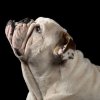Hi Roger -
I'm glad this thread has helped a bit.
A few more suggestions for you:
1) As you are starting to experiment with lights and modifiers (ie, softboxes, umbrellas, etc.), start incredibly simple. Specifically, start with nothing more than a small hot-shoe strobe, without any modifiers, 3 or 4 feet away from the animal (or puppet), in the right angle geometry that we've been discussing. Make sure the strobe is completely overpowering any ambient light in the room. Only after you have optimized the results from this configuration should you start adding things like softboxes, more light sources, etc.
To demonstrate that such a simple lighting setup can produce decent results, take a look at the attached image. I took it using exactly the lighting setup I described above. As you can see, it nicely models the shape of the cat's face, and practically every hair is sharply defined. As such, there is nothing particularly noteworthy about it, except that I took it in 1971 on Kodachrome slide film using a completely manual Nikon F and 50mm/f2 pre-AI lens. The lighting was supplied by the very first electronic flash gun I ever owned -- no modifiers at all on it. If you can't reproduce this level of detail with a modern camera, you're doing something wrong, so don't move on to a more complicated setup until you master this configuration.
2) When you are first experimenting with such matters, if you are dealing with a white animal, use a very light background, and let enough light spill onto it so that it's about as bright as the subject. If you are dealing with a black/dark animal, do the opposite and use a black background. The reason for this suggestion is to ensure that you don't have too much contrast in your image. This is of absolutely critical importance if you are running your camera+flash on "auto", but is almost as important if you are setting the exposure and flash power manually.
In the first case, the automatic exposure system of your camera will attempt to set an exposure such that mid-gray tones in the scene are recorded as mid-gray tones in the recorded image. Unfortunately, with a black cat against a white background, or the opposite, there are no mid-tones, so you wind up with blown out brights and zero'ed out blacks (which isn't exactly conducive to fur looking like fur, LOL).
In the 2nd case (manual operation), such extremes of brightness in a scene can exceed the maximum dynamic range of your camera. This has to be prevented at all costs if you want to have any hope of seeing detail in the animal's fur.
3) In addition to exposure issues, as Sierra and others pointed out earlier in this thread, sharpness is important if you want fur to look like fur, and not some blurry blob. To maximize sharpness: (a) make sure your focus is spot-on; (b) use a small aperture (eg, f11 and higher numbers on a full-frame DSLR) to have an adequate depth-of-field; (c) make sure that your strobe completely swamps any ambient light in the room (...to prevent movement ghosting); and (d) manually set the ISO of your camera to its lowest possible value. The last suggestion minimizes grain (which tends to mask the structure of fur), and ensures that your strobe will dominate any ambient light present.
HTH,
Tom









